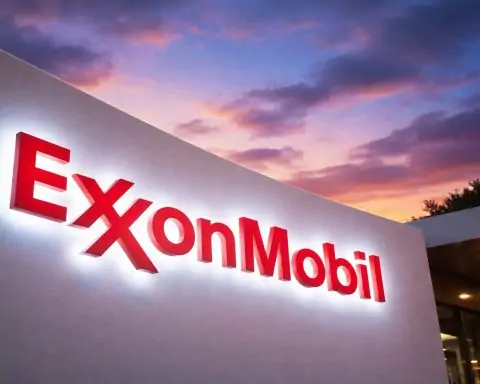- Brent crude: ~$66 per barrel (Oct 23, 2025) [1] [2]. WTI: ~$62 per barrel. OPEC Basket: ~$63.4 (Oct 22) [3].
- Recent move: Oil jumped ~5% on Oct 23 after the U.S. and EU slapped sanctions on Russia’s Rosneft and Lukoil [4] [5], pushing Brent to multi-week highs.
- Supply factors: OPEC+ has agreed to raise output in coming months [6], while global stockpiles hit multi-year highs (IEA forecasts a ~4.0 million bpd surplus in 2026 [7] [8]).
- U.S. market: Domestic crude stocks unexpectedly fell last week as refineries ramped up output, lending support to prices [9]. U.S. oil production is near record highs (~13.6 mbpd) [10].
- Energy stocks: Shares of oil and gas companies rallied. In Canada, the TSX energy sector rose ~1.5% as crude climbed [11]. Global energy indexes gained on higher crude prices.
- Analyst outlook: Many analysts say the market is awash in supply. UBS sees Brent staying roughly $60–$70 [12]. The U.S. EIA forecasts Brent averaging ~$62 in Q4 2025 and ~$52 by 2026 [13]. Others warn of risks if geopolitical tensions flare.
Current Oil Prices
As of mid‑October 23, 2025, benchmark crude prices have rebounded from recent lows. Brent crude (the global benchmark) was trading near $66 per barrel [14] [15], up sharply after news of sanctions. U.S. West Texas Intermediate (WTI) crude was around $62. OPEC’s reference basket of 15 fuels – a key price gauge – stood near $63.4 (Oct 22) [16]. In short, oil is roughly 5–7% higher than a few days earlier. This comes after a selloff in prior weeks that had sent prices to five‑month lows due to oversupply concerns.
Geopolitical and Supply Factors
Sanctions on Russia. The biggest recent catalyst was a wave of new sanctions on Russian oil giants. On Oct 22–23, the U.S. (joined by the EU and UK) blacklisted Rosneft and Lukoil over the Ukraine war. This raised fears of disruptions in Russia’s oil exports, sending prices sharply higher [17] [18]. Saxo Bank’s Ole Hansen noted that Chinese and Indian refineries – the top buyers of Russian crude – would need to find other suppliers or risk financial exclusion [19]. UBS analyst Giovanni Staunovo explains that market worries “shift[] from oversupplied markets to supply disruption concerns” when key producers face sanctions [20]. In practice, Brent futures have flipped into backwardation (near-term prices above future prices), a sign that traders see tightness in the immediate term [21].
OPEC+ output hikes. At the same time, OPEC and its allies (the OPEC+ group) have decided to unwind production cuts and add more oil to the market. Leading producers pushed for output increases in late 2025, and a deal in early October raised OPEC+ quotas for November. Reuters reports that Saudi Arabia and others plan sizable production hikes [22]. Together, higher OPEC+ supply and booming output elsewhere (U.S., Brazil, Canada, etc.) have already flooded markets. The IEA now sees global supply outstripping demand by as much as 4.0 million barrels per day in 2026 [23]. This unprecedented surplus outlook has weighed heavily on prices. The same IEA report noted that Brent was trading just below $62 in early October, compared with a 2025 low near $58 [24].
Global stockpiles. Inventories of crude oil have climbed to multi-year highs. According to the IEA, global oil stocks hit a four-year record in August 2025, largely due to China’s aggressive buying and rising exports from the Middle East [25] [26]. These glut concerns were a drag on prices all fall. For example, earlier in October a week of higher-than-expected builds in U.S. crude inventories – along with seasonal refinery maintenance – had depressed quotes. (A Reuters poll had forecast builds, not draws, last week [27].) Overall, traders note that “the implied balance…from fundamentals perspective starting in October is gaining ground,” meaning supplies likely exceed demand [28].
U.S. Production and Inventories
The United States is pumping oil at near-record rates. July 2025 saw U.S. output exceed 13.6 million barrels per day (mbpd) [29]. Faster-than-expected project ramp-ups mean the EIA now forecasts U.S. production will average 13.5 mbpd for both 2025 and 2026 [30]. Coupled with rising production in Brazil, Canada and elsewhere, global supply growth is outpacing demand growth. The EIA expects total world supply to increase by 3.0 mbpd this year and 2.4 mbpd next year [31].
At the same time, U.S. petroleum inventories tell a mixed story. The Energy Information Administration (EIA) reported that last week U.S. crude, gasoline, and distillate stocks unexpectedly fell as refiners ramped up runs [32] [33]. This decline helped support prices over the past month. Analyst Phil Flynn of Price Futures Group noted that U.S. oil demand is “above 20 million bpd”, unusually high for the shoulder season, indicating robust consumption [34]. However, analysts caution this could be temporary; refiners often draw down stocks in late summer. The EIA’s official forecast still sees rising inventories overall through 2026, pressuring prices (Brent to about $62 in Q4) [35].
Energy Stocks and Markets
Crude’s recent upswing gave energy shares a lift. In Canada, the resource-heavy TSX index climbed as its energy sector jumped about 1.5% on Oct 22, while oil itself was up ~2.2% [36]. Similarly, U.S. energy stocks (from ExxonMobil to smaller shale producers) outperformed when crude rallied. A Reuters market comment noted U.S. oil jumped above $60/bbl to a two-week high on Oct 23 [37], which helped boost related equities. Of course, broader equity markets were mixed: technology and trade worries kept indices around flat, but energy shares stood out in the green.
For example, on the New York Stock Exchange, ExxonMobil (XOM) and Chevron (CVX) saw modest gains on the day’s jump in oil prices, and U.S. drillers like Occidental Petroleum (OXY) recovered some losses. In commodity markets, crude’s spike contrasted with gold and base metals, which were mostly lower. Industry deals took a hit: some U.S. upstream M&A fell 30% in Q3 amid the weak oil pricing environment [38], reflecting investor caution. But overall, analysts say higher oil tends to improve energy companies’ outlooks – especially integrated majors and service firms – and these stocks have begun to reflect the recent rally.
Expert Insights
Market experts stress that the picture remains mixed. UBS commodities analyst Giovanni Staunovo observes that while short-term jitters have shifted to “supply disruption concerns” (due to the sanctions), the overall market is still long on crude [39]. In his view, global oil markets are “oversupplied but not in a glut”, and he expects prices to “stabilize around current levels” barring new shocks [40]. He and others note that past sanctions on Russia largely failed to curb Russian oil volumes, and alternative trade channels quickly opened up [41]. UBS explicitly forecasts Brent staying in roughly the $60–$70 range in the near term [42].
Others echo the cautious tone. Dennis Kissler of BOK Financial points out that news of rising OPEC+ output and restored flows from Iraq’s Kirkuk fields have kept “sellers present in crude” [43]. Rystad Energy’s Janiv Shah agrees that declining demand in key markets and high inventories are taking the wind out of oil’s sails [44]. Scott Shelton of TP ICAP warns that continued stock builds could push prices lower to enforce a deeper contango (future price above spot) in the curve [45].
On the demand side, analysts worry about global growth and trade. U.S.-China trade tensions – including talks of new export controls – have investors bracing for slower growth. A Reuters poll just this week showed U.S. gasoline and distillate stocks might rise, and traders speculated oil could test lower levels if tensions worsen [46].
Industry executives are similarly divided. ExxonMobil CEO Darren Woods said in mid-October that current oversupply looks “likely to be a short-term issue” and that emerging-market demand will eventually tighten the market over the medium term [47]. Occidental Petroleum’s CFO noted that, thanks to a big Berkshire Hathaway investment, Occidental’s outlook is relatively stable and that they see oil remaining “tight and range-bound” around $58–62 through 2026 [48].
Short-Term Forecast
In the near term, most observers expect oil to hold around these levels barring new shocks. “We recommend investors monitor enforcement and supply responses,” says UBS, but it does not anticipate a sustained price spike [49]. The U.S. EIA explicitly projects Brent averaging about $62 in the fourth quarter of 2025 [50] – roughly where it sits now – and then drifting down toward $52 in 2026 as inventories build.
Analyst Giovanni Staunovo expects Brent to remain roughly in the low-$60s for now [51]. Goldman Sachs and Bank of America have warned of downside risks: trade war escalations or softer demand could send Brent back toward the $50s. On the flip side, some traders note that severe weather (hurricane season) or a surprise OPEC+ cut could trigger temporary rallies.
In sum, the consensus is that oil prices will likely stay in a modest trading range near current levels (around $60–65) this fall [52] [53]. If global growth slows or OPEC+ output continues to rise, prices could ease. If supply threats mount (from sanctions or Middle East tensions), futures could edge higher. For now, experts say watchers should be ready for volatile swings around the mid-$60s as geopolitical news and inventory data come in.
Sources: Price and inventory data from EIA and Reuters market reports [54] [55]; forecasts and analysis from the IEA, EIA, UBS and Reuters news articles [56] [57] [58] [59].
References
1. www.reuters.com, 2. www.reuters.com, 3. countryeconomy.com, 4. www.reuters.com, 5. www.reuters.com, 6. www.reuters.com, 7. www.reuters.com, 8. www.eia.gov, 9. www.reuters.com, 10. www.eia.gov, 11. www.reuters.com, 12. www.reuters.com, 13. www.eia.gov, 14. www.reuters.com, 15. www.reuters.com, 16. countryeconomy.com, 17. www.reuters.com, 18. www.reuters.com, 19. www.reuters.com, 20. www.reuters.com, 21. www.reuters.com, 22. www.reuters.com, 23. www.reuters.com, 24. www.reuters.com, 25. www.reuters.com, 26. www.iea.org, 27. www.reuters.com, 28. www.reuters.com, 29. www.eia.gov, 30. www.eia.gov, 31. www.reuters.com, 32. www.reuters.com, 33. www.reuters.com, 34. www.reuters.com, 35. www.eia.gov, 36. www.reuters.com, 37. www.reuters.com, 38. www.reuters.com, 39. www.reuters.com, 40. www.reuters.com, 41. www.reuters.com, 42. www.reuters.com, 43. www.reuters.com, 44. www.reuters.com, 45. www.reuters.com, 46. www.reuters.com, 47. www.reuters.com, 48. ts2.tech, 49. www.reuters.com, 50. www.eia.gov, 51. www.reuters.com, 52. www.reuters.com, 53. www.eia.gov, 54. www.reuters.com, 55. www.reuters.com, 56. www.reuters.com, 57. www.eia.gov, 58. www.reuters.com, 59. www.reuters.com










